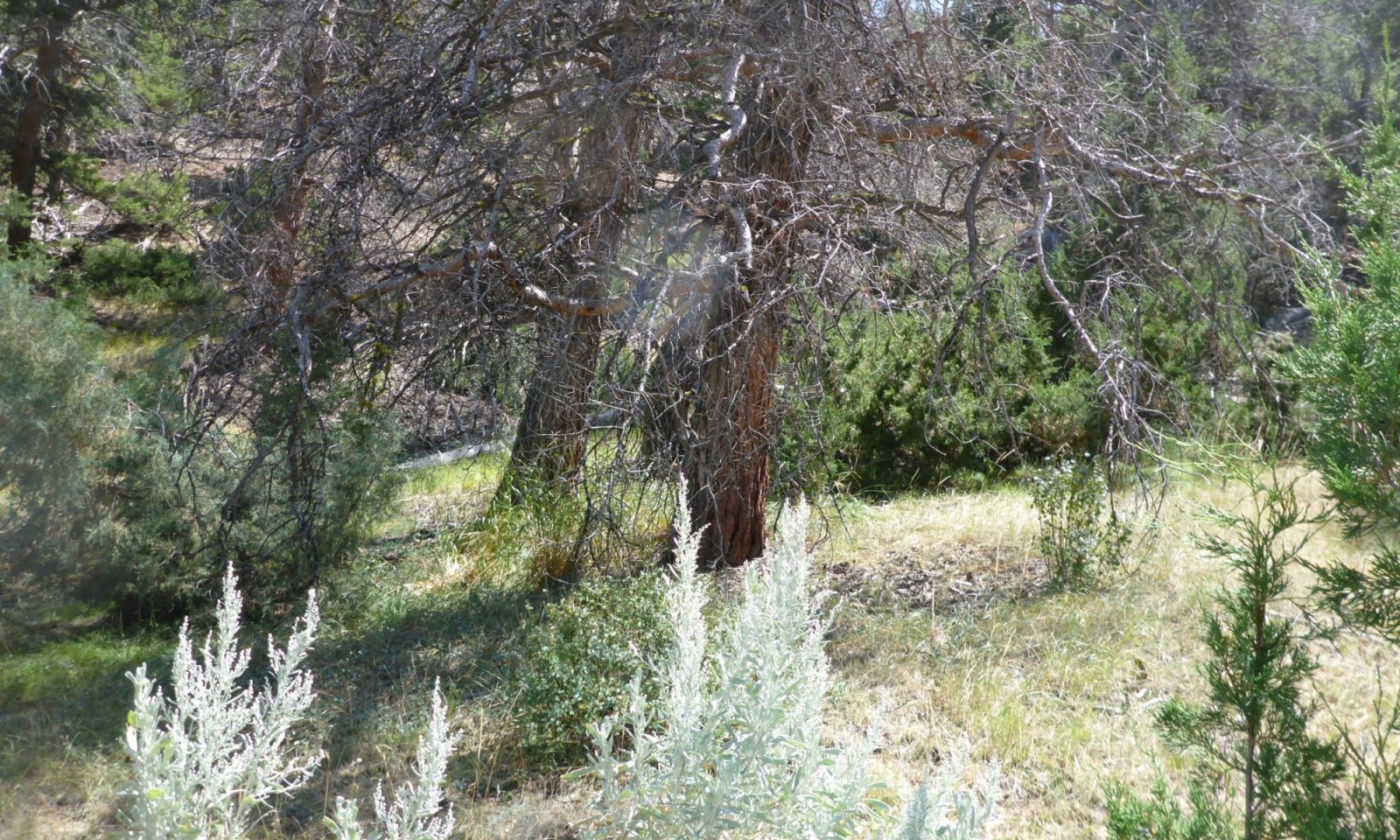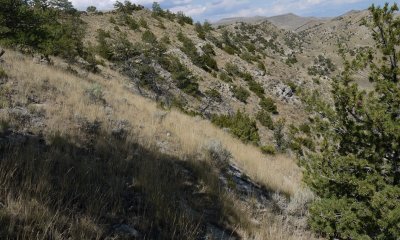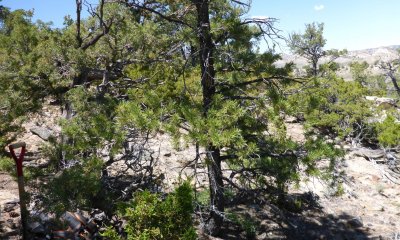
Shallow Warm Woodland Group
Scenario model
Current ecosystem state
Select a state
Management practices/drivers
Select a transition or restoration pathway
-
Transition T1A
Fire, disease or insect damage, or other canopy disturbances remove the over story, exposing the herbaceous under story.
More details -
Transition T1B
Soil disturbance or impacts to the under story cover leave this site vulnerable to invasive species.
More details -
Restoration pathway R2A
Recovery time, weed and erosion control, as well as assurance that the necessary nursery stock is present are the key factors to restoring this site.
More details -
Transition T2A
Significant canopy and soil disturbance with seed sources present lead to the degradation of the under story.
More details -
No transition or restoration pathway between the selected states has been described
Target ecosystem state
Select a state
Description
The Reference State for the Shallow Warm Woodland has a Limber pine overstory with native bunchgrasses and shrubs in present in the under story.
Characteristics and indicators
This limber pine dominated site is commonly accompanied by rocky mountain juniper and a low occurrence of Douglas-fir. The under story is comprised of bluebunch wheatgrass, Idaho fescue, threadleaf and needleleaf sedge as well as sandberg bluegrass. Common shrubs are currant, skunkbush, mahogany, and creeping juniper. Arrowleaf Balsamroot, Indian paintbrush, phlox, and cactus are common on this site as well.
Resilience management
The fire frequency on this state is low, however, it does play a role in maintaining limber pine as the dominant over story and controlling the density of rocky mountain juniper on this site.
Submodel
Description
The loss of woody canopy cover due to fire or disease characterizes the transition from the reference state to State 2 - Degraded Overstory.
Characteristics and indicators
Native grasses and grass-likes are dominant on this site. The woody canopy is reduced to cover of less than 15%, and may represent only one or two species. Following disease or other impacts to limber pine, juniper may be come dominant on the site. Bluebunch wheatgrass, Idaho fescue, threadleaf sedge, and sandberg bluegrass are the major grass/grass-like species with arrowleaf balsamroot, indian paintbrush, phlox and cactus.
Resilience management
The herbaceous cover is resistant to change and resilient. Fire is a risk and also a factor to control juniper encroachment.
Submodel
Description
The Degraded Understory State is a result of the loss of the native bunchgrasses and the establishment of invasive and aggressive species.
Characteristics and indicators
As bluebunch wheatgrass and Idaho fescue are removed from the community, sandberg bluegrass, prairie junegrass, and threadleaf sedge maintain a footprint. With drought, soil disturbance or in the removal of further understory, invasive species such as cheatgrass can take a hold in the community.
Resilience management
Once invasive species have established, the community is at risk of further degradation, and management at the current community is difficult due to the increased risk of fire and loss of site stability. Loss of the limber pine community or the general increase of Rocky mountain juniper further increases the limitations of this community.
Submodel
Mechanism
The impacts of wildfire or controlled burns, insect impacts or disease, can weaken and remove the timber cover leaving a herbaceous dominated community.
Constraints to recovery
The shallow soils, change in hydrologic factors with the loss of canopy cover and instability in the soils with loss of cover are constraints to the recover of this site. The viability of limber pine to rejuvenate on the site is also a constraint to recovery. The type and severity of disturbance influences the ability for the timber to re-establish.
Context dependence
This transition could be viewed as a transition between community phases rather than states. However, due to the time of recovery and the tenancy to transition to a less desirable community, this transition is being expressed as states.
Mechanism
Low intensity fire, or soil and canopy disturbances that impacts the under story, open the community to threat of invasion by invasive species. When seed sources are present or are introduced by wind, wildlife, livestock or recreation, this site is easily transitioned to a degraded under story community.
Constraints to recovery
The inability to control invasive species, especially with an existing canopy of woody species, and the ability to encourage native species is difficult with slopes limits the ability of this site to recover.
Mechanism
Recovery time of a disturbed site is key to allowing the re-establishment of the key species on this site. Integrated management to reduce threats of invasive or undesirable species and promoting propagation of the desired species may be needed depending on the extent of the disturbance. This restoration is part of a natural process in the recovery on a site post fire. However, with the risk of invasive species and the potential for increased fire frequency, fuel load reductions, patch burns or other management techniques may be needed to prevent this site from transitioning to a degraded under story.
Context dependence
The condition of the stand before disturbance, the species of concern in the area pre-disturbance and the impacts following disturbance are factors affecting the ability to recover. Seeding and plantings, erosion control may be necessary to stabilize the site to aid in the restoration process.
Relevant conservation practices
| Practice | External resources |
|---|---|
|
Critical Area Planting |
|
|
Mulching |
|
|
Integrated Pest Management (IPM) |
|
|
Upland Wildlife Habitat Management |
|
|
Forest Stand Improvement |
|
|
Forest stand improvement for habitat and soil quality |
|
|
Forest stand improvement pre-treating vegetation and fuels |
|
|
Forest Stand Improvement, Prescribed burning |
|
|
Forest Stand Improvement for Soil Quality |
|
|
Forest stand improvement pre-treating vegetation and fuels preceding a prescribed fire |
Mechanism
Fire or other canopy and soil disturbance opens this site to the threat of invasive species, primarily cheatgrass. In communities that have lost significant limber pine cover, and those that have severe juniper encroachment, are at risk of weed invasion following burns due to the intensity of fire and the lack of cover to maintain the site.
Constraints to recovery
The difficulty to eradicate or manage invasive species, especially on steeper slopes, limits the ability for this site to recover. Lack of soil depth, and slope again, are constraints on this site.
Model keys
Briefcase
Add ecological sites and Major Land Resource Areas to your briefcase by clicking on the briefcase (![]() ) icon wherever it occurs. Drag and drop items to reorder. Cookies are used to store briefcase items between browsing sessions. Because of this, the number of items that can be added to your briefcase is limited, and briefcase items added on one device and browser cannot be accessed from another device or browser. Users who do not wish to place cookies on their devices should not use the briefcase tool. Briefcase cookies serve no other purpose than described here and are deleted whenever browsing history is cleared.
) icon wherever it occurs. Drag and drop items to reorder. Cookies are used to store briefcase items between browsing sessions. Because of this, the number of items that can be added to your briefcase is limited, and briefcase items added on one device and browser cannot be accessed from another device or browser. Users who do not wish to place cookies on their devices should not use the briefcase tool. Briefcase cookies serve no other purpose than described here and are deleted whenever browsing history is cleared.
Ecological sites
Major Land Resource Areas
The Ecosystem Dynamics Interpretive Tool is an information system framework developed by the USDA-ARS Jornada Experimental Range, USDA Natural Resources Conservation Service, and New Mexico State University.




